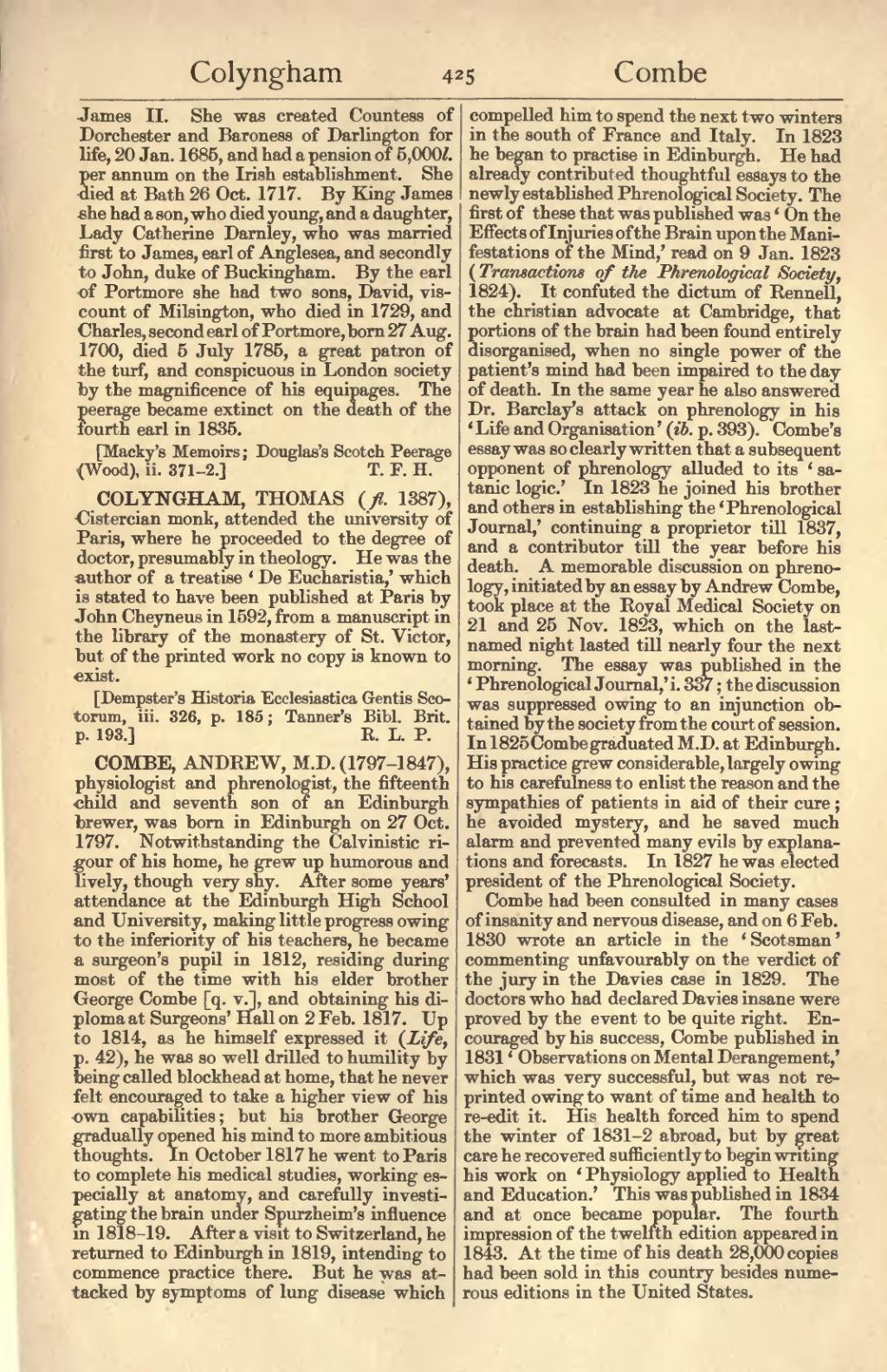James II. She was created Countess of Dorchester and Baroness of Darlington for life, 20 Jan. 1685, and had a pension of 5,000l per annum on the Irish establishment. She died at Bath 26 Oct. 1717. By King James she had a son, who died young, and a daughter, Lady Catherine Darnley, who was married first to James, earl of Anglesea, and secondly to John, duke of Buckingham. By the earl of Portmore she had two sons, David, viscount of Milsington, who died in 1729, and Charles, second earl of Portmore, born 27 Aug. 1700, died 5 July 1785, a great patron of the turf, and conspicuous in London society by the magnificence of his equipages. The peerage became extinct on the death of the fourth earl in 1835.
[Macky's Memoirs; Douglas's Scotch Peerage {Wood), ii. 371-2.]
COLYNGHAM, THOMAS (fl. 1387), Cistercian monk, attended the university of Paris, where he proceeded to the degree of doctor, presumably in theology. He was the author of a treatise 'De Eucharistia,' which is stated to have been published at Paris by John Cheyneus in 1592, from a manuscript in the library of the monastery of St. Victor, but of the printed work no copy is known to exist.
[Dempster's Historia Ecclesiastica Gentis Scotorum, iii. 326, p. 185; Tanner's Bibl. Brit, p. 193.]
COMBE, ANDREW, M.D. (1797–1847), physiologist and phrenologist, the fifteenth child and seventh son of an Edinburgh brewer, was born in Edinburgh on 27 Oct. 1797. Notwithstanding the Calvinistic rigour of his home, he grew up humorous and lively, though very shy. After some years' attendance at the Edinburgh High School and University, making little progress owing to the inferiority of his teachers, he became a surgeon's pupil in 1812, residing during most of the time with his elder brother George Combe [q. y], and obtaining his diploma at Surgeons' Hall on 2 Feb. 1817. Up to 1814, as he himself expressed it (Life, p. 42), he was so well drilled to humility by being called blockhead at home, that he never felt encouraged to take a higher view of his own capabilities; but his brother George gradually opened his mind to more ambitious thoughts. In October 1817 he went to Paris to complete his medical studies, working especially at anatomy, and carefully investigating the brain under Spurzheim's influence in 1818-19. After a visit to Switzerland, he returned to Edinburgh in 1819, intending to commence practice there. But he was attacked by symptoms of lung disease which compelled him to spend the next two winters in the south of France and Italy. In 1823 he began to practise in Edinburgh. He had already contributed thoughtful essays to the newly established Phrenological Society. The first of these that was published was 'On the Effects of Injuries of the Brain upon the Manifestations of the Mind,' read on 9 Jan. 1823 (Transactions of the Phrenological Society, 1824). It confuted the dictum of Rennell, the Christian advocate at Cambridge, that portions of the brain had been found entirely disorganised, when no single power of the patient's mind had been impaired to the day of death. In the same year he also answered Dr. Barclay's attack on phrenology in his 'Life and Organisation' (ib. p. 393). Combe's essay was so clearly written that a subsequent opponent of phrenology alluded to its 'satanic logic.' In 1823 he joined his brother and others in establishing the 'Phrenological Journal,' continuing a proprietor till 1837, and a contributor till the year before his death. A memorable discussion on phrenology, initiated by an essay by Andrew Combe, took place at the Royal Medical Society on 21 and 25 Nov. 1823, which on the last-named night lasted till nearly four the next morning. The essay was published in the 'Phrenological Journal,' i. 337; the discussion was suppressed owing to an injunction obtained by the society from the court of session. In 1825 Combe graduated M.D. at Edinburgh. His practice grew considerable, largely owing to his carefulness to enlist the reason and the sympathies of patients in aid of their cure; he avoided mystery, and he saved much alarm and prevented many evils by explanations and forecasts. In 1827 he was elected president of the Phrenological Society.
Combe had been consulted in many cases of insanity and nervous disease, and on 6 Feb. 1830 wrote an article in the 'Scotsman' commenting unfavourably on the verdict of the jury in the Davies case in 1829. The doctors who had declared Davies insane were proved by the event to be quite right. Encouraged by his success, Combe published in 1831 ' Observations on Mental Derangement,' which was very successful, but was not reprinted owing to want of time and health to re-edit it. His health forced him to spend the winter of 1831-2 abroad, but by great care he recovered sufficiently to begin writing his work on 'Physiology applied to Health and Education.' This was published in 1834 and at once became popular. The fourth impression of the twelfth edition appeared in 1843. At the time of his death 28,000 copies had been sold in this country besides numerous editions in the United States.
